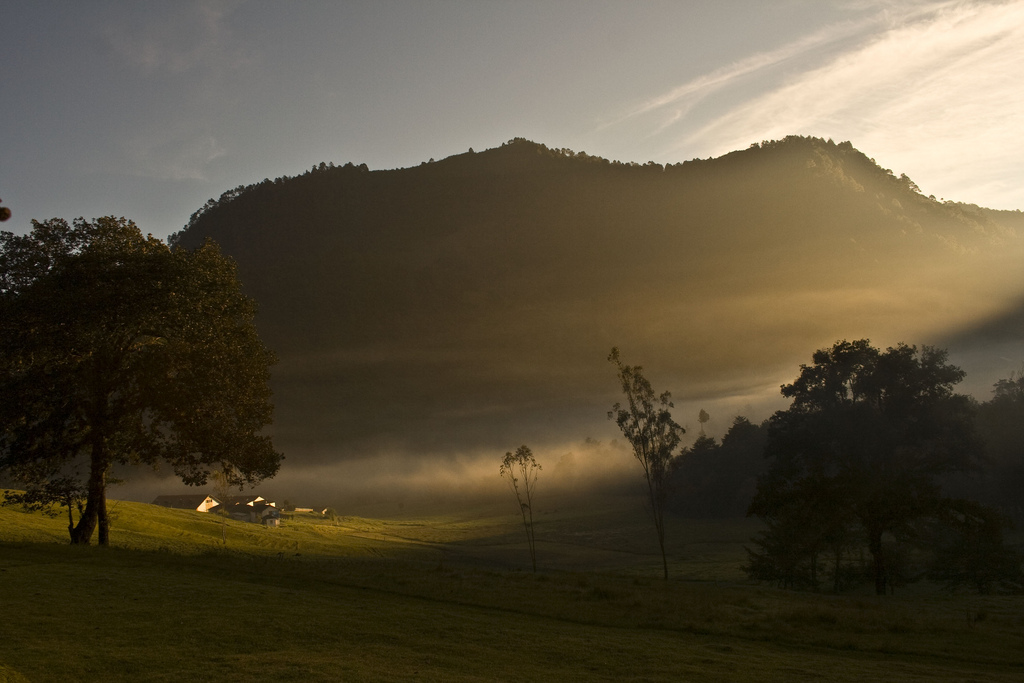
Morning in beautiful Nebaj, Guatemala. Photo © Javier Ruata, licensed Creative Commons Attribution.
Community tourism initiatives, whereby local Maya guides take travelers to seldom-seen locales in Guatemala’s rugged countryside, make for some extraordinary cross-cultural opportunities. You’ll have the chance to stay in basic accommodations with Mayan families along the way, thus contributing directly to their economic well-being and greatly enhancing the cultural experience. Although many areas of Guatemala feature community tourism initiatives, this strategy details a selection from highland regions of the country.There are several excellent treks leaving from the town of Nebaj, in El Quiché department’s Ixil Triangle. Perhaps the most popular hike from here is a three-day Nebaj–Todos Santos trek across the Cuchumatanes mountain chain, where you’ll encounter Andean scenery the likes of grassy plains strewn with rocky boulders in addition to Mam-speaking indigenous peoples herding sheep and llamas. Other overnight hikes from Nebaj lead west to picturesque lagoons near an area known as Las Majadas or to the villages of Xeo and Cotzal. Many hikers favor this route for the chance to get up close with the local culture in seldomvisited Mayan villages. The Ixil Triangle, as you may recall, was hard-hit during the country’s civil war but is today one of Guatemala’s best-kept secrets. The scenery alone makes the trip worthwhile, but the chance to take in the friendly indigenous Maya culture makes this trip memorable.
This town lies along a back-door route between the departmental capital of Santa Cruz del Quiché and Alta Verapaz, to the east. Recreational opportunities include hikes through the backcountry to the wonderful waterfall of Los Regadillos, hikes to Peña Flor and the neighboring site of Tzunun Kaab’, and hiking or biking to the agricultural village of Cholá, where you can bathe in a refreshing spring-fed pool. You can also visit Laj Chimel, the birthplace of Nobel Peace Prize laureate Rigoberta Menchú and the gateway to Guatemala’s fourth-largest cloud forest. You can try your luck at spotting the elusive quetzal (Guatemala’s national bird) and other exotic species. Local Maya guides take visitors to far-flung locales such as Mirador El Quetzal, with spectacular views of the Ixil Triangle flanked by the Sierra de los Cuchumatanes, and lovely Laguna Danta. The community provides camping in a covered platform and basic lodging in an adobe guesthouse.
East of Uspantán, the town of Chicamán has also caught on to ecotourism and serves as the gateway to the seldom-explored Rio Chixoy. About 14 kilometers away, it’s most easily visited from the hamlet of El Jocote via a community tourism initiative. A full day of river tubing includes three hours afloat on the cool, turquoise-colored river ending at a spectacular waterfall, a jungle hike, and lunch in a local community. You also have the option of staying overnight in a very comfortable and quaint wooden cabin.
Some of the best hiking anywhere in Guatemala, and Central America for that matter, can be found in the Sierra de las Minas Biosphere Reserve. Several trails wind through this remote wilderness, allowing the opportunity to spot Guatemala’s national bird, the quetzal, and explore its unique cloud forest habitat. Starting in the village of San Rafael Chilascó, hook up with the local Community Tourism Organization for hikes to the nearby waterfall of El Salto de Chilascó, one of Central America’s highest waterfalls. Longer, more challenging hikes take you up the mountain spine of Lomo del Macho and deep into the cloud forest to a research station at Albores and the Peña del Ángel rock formation.
Excerpted from the Fourth Edition of Moon Guatemala.